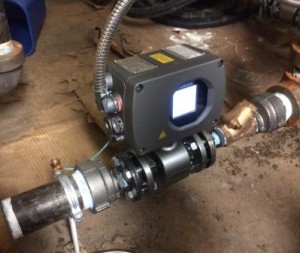Typical steam distribution systems rely on steam flow measurements as a way to measure and bill energy usage at a given point-of-use (building or structure, Heat exchanger, fan coil unit, etc.). Does measuring and billing this way make a major assumption that may not be true?
News and Events
New Milestone for CMAG in Pumped and Gravity Condensate Applications
Central Station Steam is proud to announce the sale of our 1000th CMAG meter for condensate service. Originally designed for pumped condensate service with no flow profiling or piping straight run required, the CMAG has now been customer proven to be an excellent choice for gravity service as well! Innovative flow tube and electronic design […]
Flowmeter Accuracy Vs. Repeatability
Although some believe that good repeatability is a measure of accuracy, this is a misconception. Repeatability is in no way an accuracy guarantee. Therefore, when considering a measurement device, if you see only a repeatability statement and no accuracy statement, be cautious and consider your application. Repeatability is the ability of a system or device […]
Flow Meters And LEED: Your Green Building Certification
LEED certifications are obtained through a points-based evaluation in several building categories. One of those categories is water efficiency, which is of course, where flow meters come in.
Selecting A Flow Meter For Pressurized Systems
It’s easy to choose the wrong flow meter. There are many different meter technologies on the market today, all with their own strengths and weaknesses. These variations in functionality and performance are very important to consider when selecting the most appropriate measurement device for your system. The level of accuracy and performance that operators prefer […]
Types Of Volumetric Flow Meters
Flow meters measure the amount of liquid, gas or vapor passing through a piping system. Most flow meters are designed to measure the velocity, or speed at which the fluid flows through a pipe. They use that information along with the pipe’s inner cross sectional area to calculate volume, or the amount of fluid passing […]
Not All Flow Meters Are Created Equal!
As energy usage has become a lightning rod for conversation and studies regarding efficiency, the ability to measure and quantify energy consumption has become forefront in the battle to get a handle on what is being used and how efficient or inefficient that use may be. However, before we can truly measure consumption, we really […]
Truth in Specsmanship, Part 3
This time I will review the specsmanship of a single turbine insertion style meter. Its manufacturer infers the meter’s performance by once again mixing and matching information in an attempt to project its capabilities beyond what is possible. On the product’s specifications document the manufacturer lists the meter’s accuracy capabilities in three ways shown below: […]
Truth in Specsmanship, Part 2
This installment of “Truth In Specsmanship” will examine the insertion magmeter technology as it relates to turndown. Turndown is the operating range of a given meter, based on the maximum operating velocity, divided by the turndown factor. For example, suppose a meter has a maximum operating range of 30 ft/s and a turndown of 100:1. […]
Truth in Specsmanship, Part 1
Most of today’s flow technologies (paddle wheel, turbines, orifice plates, variable area, pitot tube, vortex, and magnetic) are volumetric, meaning that these devices measure velocity and then calculate volume by using a known cross section area (Velocity (feet/second) x Area (Ft2) = Volumetric flow rate (ft3/s)). In all cases, the higher the velocity the easier […]
